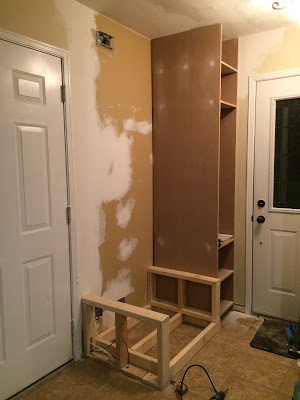Almost 6 years ago we looked at what would eventually become our house for the first time. My very first comment? I don't like the entryway. It was incredibly small and tight. You couldn't even stop to take off wet, muddy shoes as the person behind you would be bumping into you and unable to close door. We like the house overall and bought it but in my head, this hallway was always going to need some work! The popcorn ceiling also wasn't my favourite feature but knowing that one needed to happen at the same time as the other, it all got pushed back again and again. Finally, we had some pot lights installed and the dining room light fixture moved and needed to fix holes in the ceiling. There was no way I was putting up more popcorn so the day came.
I didn't take nearly as many photos as I should and, most disappointingly, I didn't get a before picture. (This was because I came home from England to find the hallway closet demolished by my super helpful husband!) Imagine a built-in closet that came all the way to the edge of the door leaving no room to maneouver, and all the way to the garage door. It was tight, closed off and dingy.
 |
| This is what welcomed me home after an 8 hour flight! |
Eventually, we got all remaining framing out, re-routed the electrical (apparently the original builders decided this was a perfect place to run the stove and dryer electrical work) with the help of an electricial friend and drywalled everything back up. Thanks to some interesting framing by the builder, I ended up having to replace the drywall on half the ceiling as well as the obvious spots on the walls. Gotta love when jobs give giving! I left a piece of the original wall as this would be used as part of the bench's base and save more electrical work.
With the help of my dad and his router, and my 5 year old nephew, we made a much smaller closet. The large section in the middle is long enough to hang coats (I measured my longest coat!) and there are four spaces to fit baskets for hats, gloves and scarves.
I then set about making a base for my storage bench. Because I wanted to use the existing framework, include storage space, work around some tricky corners and cover the hole in the tile, it ended up being an interesting frame job. I wouldn't follow my design and I wouldn't choose to build a bench in the same way again but it worked. Less wood would be just as sturdy but in this situation would have been a much bigger hassle trying to attach everything together.
I finished framing the bench and closed it in. I used a combination of drywall and MDF to close in all the sides and inside, needing to keep the junction boxes that were hidden in the back accessible. I gave it some trim detail to look a little more interesting and then it was time for some paint!
 |
| Already the hallway is looking larger and brighter! |
My original plan had been to sew a cushion for the top but once I got this far, it just seemed too...white. I ended up buying a piece of luon and staining it to match the large box I made for the space under the bench. I put up a shelf and ended up making the gables as I couldn't find any as simple as I wanted. You could buy them cheap at any hardware store though! Attached some hooks and a hanging rod, and voila!
 |
| The wall still needs repainting but you can see the hanging and shelf space. |
 |
| Finally, wall is repainted and a fun pop of colour added to the front door! |
I still need to build a door to close in the mini closet but that's going to have to wait, and really, it works just fine without it. When we get back into this house, the walls are going to become a grey colour and the light fixture will be updated to something more industrial/vintage. But for now, I'm in love!
Tutorial coming soon on the little wooden sign sitting on the top shelf...
What do you think? Have you got any ideas of how to make your entryway feel bigger and brighter? What part of your house have you always wanted to change?













